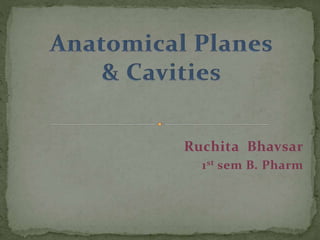
Anatomical planes & cavities
- 1. Ruchita Bhavsar 1st sem B. Pharm
- 2. Introduction to Anatomy Definition Introduction to Anatomical Terms Anatomical Positions Anatomical Planes Body Cavities Summary Reference
- 3. Human anatomical terms make up a distinct nomenclature to describe areas of the body, to provide orientation when describing parts of human anatomy, and to distinguish different movements of the body. An understanding of these terms is necessary to study the human body in depth. Many of these terms are also applicable in animal anatomy (zootomy).
- 4. Anatomy is the study of the structure of the human body Anatomic terms describe the directions within the body as well as the body’s reference positions, planes and cavities.
- 5. Anatomists use specific terms to indicate visible areas of the body. The cephalon or cephalic region refers to the head. This area is further differentiated into the cranium (skull), facies (face), frons (forehead), oculus (eye area), auris (ear), bucca (cheek), nausus (nose), oris (mouth), and mentis (chin). The neck area is called the cervicis or cervical region.
- 7. superior - closer to the head Inferior - closer to the feet reference point - horizontal plane posterior (dorsal) - closer to the posterior surface of the body anterior (ventral) - closer to the anterior surface of the body reference point - frontal or coronal plane medial - lying closer to the midline lateral - lying further away from the midline reference point - sagittal plane proximal - closer to the origin of a structure distal - further away from the origin of a structure reference point - the origin of a structure
- 9. The three basic planes intersect at right angles to each other. When the three basic planes intersect in the center of the body (as seen in the image to the right) they can be used to describe various relationships within the body. Main Reference Planes :- i. Sagittal Plane ii. Coronal Plane iii. Transverse Plane iv. Oblique Plane
- 10. i. Sagittal plane (median, wheel) — this vertical (top to bottom) plane divides the body into left and right sides; a plane that divides the body down the middle into equal left and right sides is the Median Sagittal Plane. ii. Coronal plane (vertical, frontal, door) — a vertical plane that divides the body into front (anterior or ventral) and back (posterior or dorsal) iii. Transverse plane (horizontal, table) — this horizontal plane is parallel to the ground and divides the body into up (toward the head) and down (toward the feet) iv. Oblique plane is not shown; it is a slanted plane (at an angle) that lies between the horizontal and vertical planes.
- 14. Body cavities are areas in the body that contain our internal organs. The dorsal and ventral cavities are the two main cavities. The dorsal cavity is on the posterior (back side) of the body and contains the cranial cavity and spinal cavity. The ventral cavity is on the front (anterior) of the body and is divided into the thoracic cavity (chest) and abdominopelvic cavity.
- 15. The dorsal cavity is further divided into sub cavities: 1. Cranial Cavity 2. Vertebral Cavity Cranial cavity (also called the calvaria) which surrounds and holds the brain Vertebral cavity (also called the spinal cavity) which includes the vertebrae (spinal column) and spinal cord.
- 16. The ventral cavity is on the front of the trunk. The diaphragm (the main muscle of breathing) divides the ventral cavity into two simple sub cavities: 1. Thoracic Cavity 2. Abdominopelvic Cavity Thoracic cavity which is surrounded by the ribs and chest muscles is superior to the diaphragm and abdominopelvic cavity. It is further divided into the pleural cavities (left and right) which contain the lungs, bronchi, mediastinum which contains heart, pericardial membranes, large vessels of the heart, trachea, upper esophagus, thymus gland, lymph nodes, blood vessels and nerves.
- 17. Abdominopelvic cavity is divided into the abdominal cavity and pelvic cavity. The abdominal cavity is between the diaphragm and the pelvis. It is lined with a membrane and contains the stomach, lower part of the esophagus, small intestine,large intestine, spleen, liver, gallbladder, pancreas adrenal glands, kidneys and ureters. The pelvic cavity contains the bladder, some reproductive organs and the rectum.
- 18. oral cavity – the space in the mouth inside the teeth and gums and is filled with the tongue when it is relaxed. nasal cavity – in the nose orbital cavities (left and right) – hold the eyes middle ear cavities (left and right) – hold the small bones of the middle ear synovial cavities – are inside the joint capsules that surround freely moving joints (such as the hip, knee, elbow, and shoulder)
- 19. The international standard anatomical position is the position that provides a reference point for describing the structures of the human body. In this position, the body is standing erect with good posture and the face is looking directly forward. The feet are about six inches apart, flat on the floor and the toes pointing forward. The arms are down at the sides with the palms turned forward and thumbs pointing away from the body. When the body is lying face down in the anatomical position, this is called the prone position. When the body is lying face up, this is called the supine position.
- 20. Elements of Human Anatomy, Physiology & Health Education - by Dr. R. K. Goyal Human Anatomy and Physiology for Pharmacy – by Prof. A. K. Jain